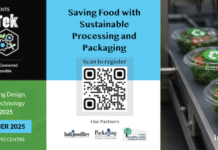Recent food scandals, such as contaminated milk powder or rotten meat, have made one thing clear: counterfeit products in the food industry have a drastic impact. Not only do they endanger the health of consumers, they also damage confidence in a brand or an entire industry. Modern serialization technologies make it easier for retailers and consumers to identify original products and track product routes more transparently. Syntegon, formerly Bosch Packaging Technology, has transferred its know-how from the pharmaceutical sector to the food industry and supports customers in the step-by-step implementation of serialization solutions.
In 2008, milk powder contaminated with melamine, a chemical used in plastics production, caused the death of at least six children in China; hundreds of thousands of babies fell ill – as case that consumers will not forget. The same goes for the horse meat scandal of 2013, when producers labelled and exported cheap horse meat as beef. This kind of food scandals not only acutely endanger the safety of consumers, but also their confidence in the brand. Counterfeit-proof products are therefore of primary concern. However, many food producers are not sure what they need to consider for implementation. Here, the pharmaceutical industry can provide answers with existing solutions.
Serialization creates counterfeit protection and trust
In the strictly regulated pharmaceutical industry, country-specific regulations on mandatory labelling have gained enormous momentum in recent years. Data matrix codes on folding cartons that allow the origin and authenticity of a drug to be traced are already common practice in many cases. They protect consumers from dangerous counterfeit medicines and strengthen confidence in the products. In the food industry, packaging labels have so far only been commonly used to indicate the ingredients, a nutrition table, as well as information on the best before date and manufacturer. Exact codes with further information are still rare. However, data matrix codes hold great potential for some products.
Traceability of original products should be mandatory, especially for baby food, which requires the highest level of hygiene safety. Both retailers and end consumers would have complete transparency about the origin, authenticity and integrity of a product. Serialization also makes sense for high-priced spirits such as whisky. This could prevent products from being counterfeited or diluted with cheap substances, which might cause health issues. Another potential application is the complete traceability of meat products. Consumers would have certainty about where and how the animal was kept, where it was slaughtered and whether it really is of the declared organic quality. More widespread serialization in the food sector could help to increase consumer confidence in the products consumed.
Codes for each product?
Retailers and supermarkets also benefit from product serialization: the supply and cold chain of a product can be tracked transparently and reliably via the printed data matrix codes, while further relevant data can be accessed at any time. Many retailers are facing the challenge of selling their products before the expiration date. If products such as yoghurts had a serialization code, retailers could find out more easily how many products are about to expire and automatically make changes, for example to electronic price tags. This accelerates the sale of goods and avoids food waste.
The serialization of food products enables manufacturers, retailers and consumers to track products seamlessly – from origin to logistics to sale. In some countries, such as South Korea, there is already a trend towards codes on food packaging. It is predicted that serialization to actively prevent food scandals and increase safety and transparency for the end consumer will increase in the coming years. However, the individual marking of each product means additional effort for manufacturers. The introduction of a suitable serialization solution entails investment costs as well as process adaptations. Hence, the willingness to change certain processes is the basic prerequisite for a successful introduction, while experience can help with the concrete implementation. This experience exists, mainly in the pharmaceutical industry, where many manufacturers have already completed the process.
Step by step to complete serialization
The first step usually involves bringing all affected departments together. Assigning the task to employees from maintenance and repair will not be enough; the introduction of serialization technology is a comprehensive process. In addition to production, departments such as marketing are also affected, since packaging design is influenced by the changes. It is also important to inform and involve suppliers as well as cooperation and trading partners. Data management is one of the central challenges in concrete implementation. While pharmaceutical serial numbers are generated by authorities and made available to manufacturers in many countries, there are few specifications in the food industry to date. Manufacturers must manage their data autonomously and dedicate themselves to the topic of data security and management.

The easiest way for manufacturers to do this is to combine machines and IT into a comprehensive solution. For this purpose, Syntegon (formerly Bosch Packaging Technology) has developed the CPI software, which ensures easy integration into existing IT infrastructures. The company draws on many years of experience in the pharmaceutical sector. In addition to the CPS serialization modules, which print data matrix codes on the smallest packaging units such as cartons, aluminum lids or bottles, CPA modules ensure the product aggregation of different packaging levels such as bundles, crates or pallets. The CPI solution is used to connect the physical machines with the company’s IT. In this way, an integrated serialization and aggregation process can be implemented step by step.
‘Yoghurt in the Cloud’ pilot project
With the ‘Yoghurt in the Cloud’ pilot project, the experts from Syntegon have implemented an initial application involving the serialization of yoghurt packaging in the food sector. The aim was to achieve greater transparency throughout the entire supply chain. The manufacturer’s packaging machine is connected to Syntegon’s CPI software. Using the data matrix code printed on the lid of the yoghurt pot, consumers can easily check whether they have purchased an original product and whether the cold chain has been maintained. All they need is a scanner, which is available on almost all smartphones. In the event of product defects, consumers can immediately inform the manufacturer and help him to ensure product quality. Manufacturers, on the other hand, can provide consumers with additional information about the product, such as allergens, ingredients or recipes.
Even though the implementation of serialization solutions initially requires a significant investment in terms of time and costs, it offers the food industry additional protection for its products – and ultimately for consumers. Whether it’s dairy products, baby food or expensive spirits, serialized products help determine the authenticity of food and protect manufacturers and their image of falling victim to counterfeiters.











